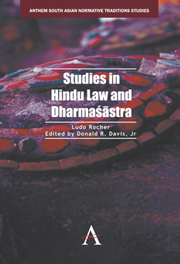Book contents
- Frontmatter
- Contents
- Foreword by Richard W. Lariviere
- Preface
- Abbreviations
- Note on the Edition
- Introduction
- PART ONE THE NATURE OF HINDU LAW
- PART TWO GENERAL TOPICS OF HINDU LAW
- PART THREE HINDU LEGAL PROCEDURE
- PART FOUR TECHNICAL STUDIES OF HINDU LAW
- Possession Held for Three Generations by Persons Related to the Owner
- The Vīramitrodaya on the Right of Private Defence
- The Technical Term Anubandha in Sanskrit Legal Literature
- The Kāmasūtra: Vātsyāyana's Attitude toward Dharma and Dharmaśāstra
- In Defense of Jīmūtavāhana
- Dāsadāsī
- The Definition of Vākparuṣya
- Janmasvatvavāda and Uparamasvatvavāda: The First Chapters on Inheritance in the Mitākṣarā and Dāyabhāga
- Karma and Rebirth in the Dharmaśāstras
- Notes on the Technical Term Sāhasa: “Fine, Pecuniary Penalty”
- Avyāvahārika Debts and Kautilya 3.1.1–11
- The Sūtras and Śāstras on the Eight Types of Marriage
- Caritraṃ Pustakaraṇe
- The Terms Niyukta, Aniyukta, and Niyoga in Sanskrit Legal Literature
- The Aurasa Son
- The Introduction of the Gautamadharmasūtra
- PART FIVE ANGLO-HINDU AND CUSTOMARY LAW
- Bibliography
- Index
Notes on the Technical Term Sāhasa: “Fine, Pecuniary Penalty”
from PART FOUR - TECHNICAL STUDIES OF HINDU LAW
Published online by Cambridge University Press: 05 February 2013
- Frontmatter
- Contents
- Foreword by Richard W. Lariviere
- Preface
- Abbreviations
- Note on the Edition
- Introduction
- PART ONE THE NATURE OF HINDU LAW
- PART TWO GENERAL TOPICS OF HINDU LAW
- PART THREE HINDU LEGAL PROCEDURE
- PART FOUR TECHNICAL STUDIES OF HINDU LAW
- Possession Held for Three Generations by Persons Related to the Owner
- The Vīramitrodaya on the Right of Private Defence
- The Technical Term Anubandha in Sanskrit Legal Literature
- The Kāmasūtra: Vātsyāyana's Attitude toward Dharma and Dharmaśāstra
- In Defense of Jīmūtavāhana
- Dāsadāsī
- The Definition of Vākparuṣya
- Janmasvatvavāda and Uparamasvatvavāda: The First Chapters on Inheritance in the Mitākṣarā and Dāyabhāga
- Karma and Rebirth in the Dharmaśāstras
- Notes on the Technical Term Sāhasa: “Fine, Pecuniary Penalty”
- Avyāvahārika Debts and Kautilya 3.1.1–11
- The Sūtras and Śāstras on the Eight Types of Marriage
- Caritraṃ Pustakaraṇe
- The Terms Niyukta, Aniyukta, and Niyoga in Sanskrit Legal Literature
- The Aurasa Son
- The Introduction of the Gautamadharmasūtra
- PART FIVE ANGLO-HINDU AND CUSTOMARY LAW
- Bibliography
- Index
Summary
Sāhasa is a well-known technical term in classical Hindu law. It has its regular place in the enumerations of vivādapadas, i.e., the —normally eighteen— “titles of law.” For example in Manu's list of vivādapadas (8.4–7), the śloka containing titles ten to fifteen runs as follows:
sīmāvivādadharmaś ca pāruṣye daṇḑavācike ∣
steyaṃ ca sāhasaṃ caiva strīsaṃgrahaṇam eva ca ∣∣
“(10) Disputes regarding boundaries, (11) assault and (12) defamation, (13) theft, (14) robbery and violence, (15) adultery” (trans. Bühler: 253).
There may be some doubt about the exact connotation of the term sāhasa even within a single text such as the Manusmṛti and Bühler's “robbery and violence” may only be partly valid. On the one hand, sāhasa seems to refer to “violent appropriation,” different from steya only insofar as the latter indicates appropriation in the absence of the owner and, hence, without violence. Thus MDh 8.332:
syāt sāhasaṃ tv anvayavatprasabhaṃ karma yat kṛtam ∣
niranvayaṃ bhavet steyaṃ hṛtvāpavyayate ca yat ∣∣
“An offense (of this description), which is committed in the presence (of the owner) and with violence, will be robbery; if (it is committed) in his absence, it will be theft; likewise if (the possession of) anything is denied after it has been taken” (trans. Bühler: 312). On the other hand, sāhasa is clearly distinguished from steya; says MDh 8.345:
vāgduṣṭāt taskarāc caiva daṇḑenaiva ca hiṃsataḥ ∣
sāhasasya naraḥ kartā vijñeyaḥ pāpakṛttamaḥ ∣∣
- Type
- Chapter
- Information
- Studies in Hindu Law and Dharmasastra , pp. 565 - 580Publisher: Anthem PressPrint publication year: 2012



